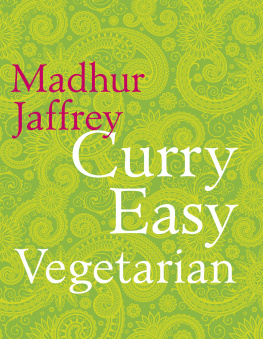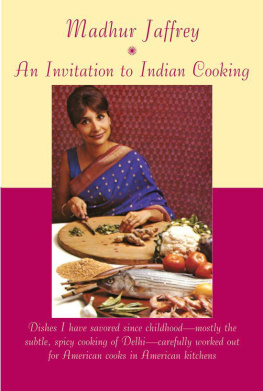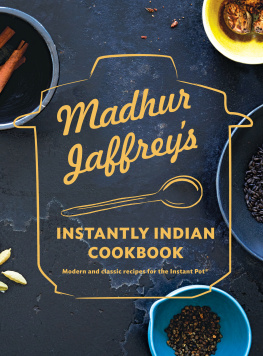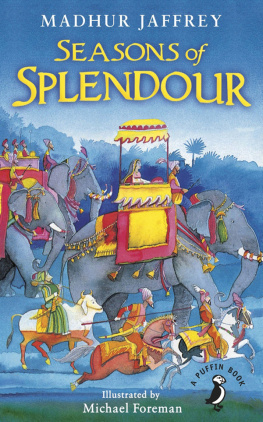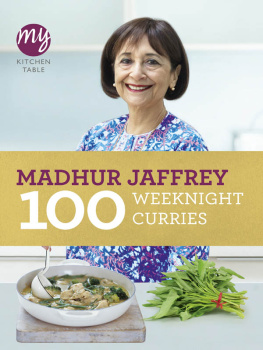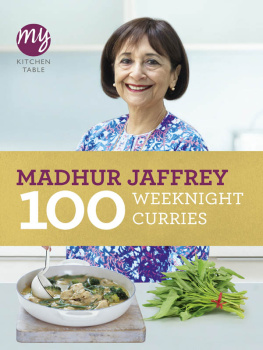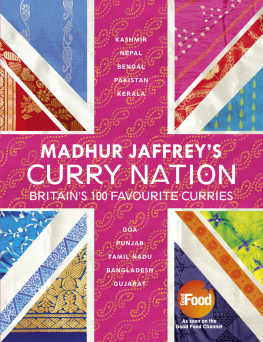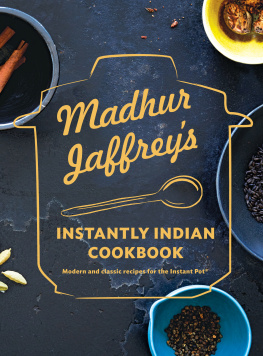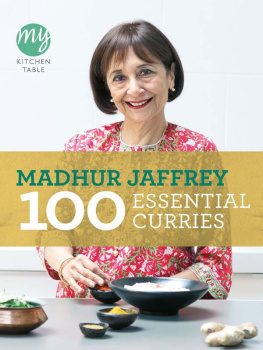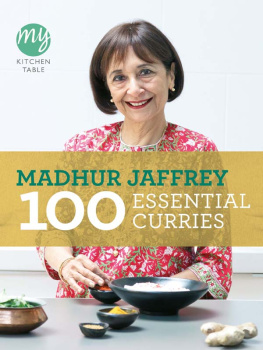Contents
About the Book
Indian vegetarian foods are perhaps the most flavourful and the most varied in the entire world.
Vegetarian dishes, bursting with taste and delicately spiced, are at the heart of delicious Indian food. In this stunning new book Madhur Jaffrey, the world authority on Indian cooking, offers a definitive and inspiring collection of over 200 brand new dishes.
Madhurs recipes are simple to follow and dont involve hours in the kitchen. Her encouraging guidance and invaluable tips for getting the best out of each ingredient will allow you to create authentic dals, mouthwatering curries, delicious stir-fries and wonderful dosas, snacks and sides without ever compromising on great flavour.
About the Author
Now regarded by many as the world authority on Indian food, Madhur Jaffrey was born in Delhi and is an award-winning actress and bestselling cookery author. Her first book, An Invitation to Indian Cookery, was published in 1973 and since then she has written over 15 cookbooks, now considered classics in their field, including Madhur Jaffreys Ultimate Curry Bible and Madhur Jaffreys World Vegetarian. She has appeared in over 20 films, including Merchant Ivorys Heat and Dust and Cotton Mary. In 2006 she published her memoir of childhood, Climbing the Mango Trees.
This Book is Dedicated to those in the Food World,
Alive or Departed,
Who Inspired me,
Taught me,
Encouraged me,
Were Kind to me,
And
Helped me
In a Variety of Thoughtful Ways
Julia Child
Craig Claiborne
Judith Jones
James Beard
Jane Grigson
Elizabeth David
Billy Cross
Michael James
Marcella and Victor Hazan
Alice Waters
Niloufer King
Catherine Brandel
Donald Sloan
Introduction
Indian vegetarian foods are perhaps the most flavourful, the most nutritionally balanced, and the most varied in the entire world. Many are of ancient origin or inspiration, seasoned with an array of spices carefully blended for both health and taste.
With this book, I want to take you on an adventurous ride through India, tasting the real vegetarian dishes that Indians eat in the privacy of their homes, in their very local cafs and temples, at the parties they throw for each other, and at their wedding banquets and religious festivals. Some may be completely unfamiliar to you, though not to those who have travelled and eaten in homes in Kerala or Tamil Nadu, Karnataka or Kashmir, Delhi or the Punjab. Even if they are unfamiliar, they are easy to put together.
Just imagine crisp okra fries dusted first with chilli powder, turmeric and chickpea flour, or grilled Portobello mushrooms flavoured simply with green chillies, squeezes of lime juice and salt, or a hot, sweet and sour mash of aubergines on toast. You will find all these in the very first chapter Soups, Appetizers & Snacks.
The vegetable chapter holds more good things. Some of you may, just may, have had the sweet, sour, hot, salty and coconut-enriched Kodava Mushroom Curry that originated with the hunter-gatherers of the forested regions of Coorg in southern Karnataka, though I doubt it. It is so easy to make, yet is never on any restaurant menu in the West. You will find that recipe here, along with a sublime spinach stir-fried with garlic, cumin and fenugreek seeds, and some potatoes from Goa studded with mustard seeds and refreshed with green chillies and fresh coriander.
Indians eat more dals dried beans and legumes than perhaps any other country. From black-eyed peas to lentils, mung beans and even soya granules, we cook them every day and each time in a different manner. For Indians these ingredients are a protein-rich mainstay. In you will find dozens of recipes that might well change the look of your daily meals forever.
An American friend once said that she ate an exquisite poha upma in a hotel in Madhya Pradesh. A what? She too did not know the name or what it was she was eating. She just knew that she has yearned for it ever since. You will find that recipe here in I am sure you will want to use it frequently.
As I travelled around India for this book, I kept my eyes wide open for vegetarian dishes that are both delicious and easy to make. India has so many of them, and we all need them in our repertoire. But I am going to make you go running to Indian shops to get a few new ingredients to add to your store-cupboard. Poha will be among them, as you will not find it in your local supermarket. At least not yet. Very few Indian ingredients were available when I first started writing cookbooks. But today cardamom and coriander, which I could not find back then, are in every supermarket. What is even better, you can sit comfortably at home and order almost everything you need online. Poha is a great new ingredient to learn about. I just cannot wait to introduce it to you. Indian vegetarians always have it in their larders to make a very quick snack if unexpected guests show up. You should too.
For this book I have collected recipes for Mung Bean Pancakes from Andhra, a Potato Salad from Nepal, a superb Egg Curry in a Spicy Tomato Sauce from the aristocratic families of Hyderabad, and lovely potato dishes from the Marwari business community that originated in the deserts of Rajasthan.
I am equally interested in how different Indian communities eat their eating habits and their menus as these offer true glimpses into the different vegetarian worlds within India. You will get to know some of these people as I did. Food, as we all know, does not exist in a vacuum. I always like to know the context and background of the dishes I eat. I hope you do too, and I have done my best to provide both.
In Bombay, I followed two very successful vegetarian jewellers to see what they ate for lunch and how they ate it. Both have shops at the Taj Mahal Hotel in the city. One, who comes from Varanasi in Uttar Pradesh, left his office every day around noon and went home to his family for lunch, the main meal of the day. He spent about 1 hours eating and then went back to his office. His father, who had replaced him for that time, now took his car and went back to the same home (they all live together) to have his lunch. You will find the details of that meal, as well as the full menu, .
.
I was also very curious about the hundreds of ashrams in India. They all serve vegetarian food. What were they like and what did they serve? Did they have certain culinary principles that they followed? The Aurobindo Ashram in Delhi is located in a stunning modern building, where the round, granite dining room, right at its heart, is open to the sky in the centre. Anyone who is hungry is welcome to go in and eat for free. The food, originating from all over India, is always made with very fresh ingredients, some grown on the premises, and is always mildly spiced and never too oily. See more about this .
For this book I have also created quite a few modern dishes that use traditional Indian spices and techniques but have Western origins, such as Pan-grilled Courgettes with Spicy Tomato Sauce, and Mangoes Mumtaz, a lovely light, fluffy dessert (see ).

